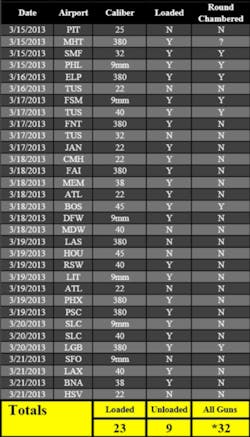To its credit, TSA continues to do its mandated job: finding weapons and other prohibited items at screening checkpoints throughout the country. The chart shows just one week of guns discovered during mid-March, and contrary to my own view that they might be concentrated in one region, they are pretty much everywhere. The same week yielded eight stun guns in carry-on and eight inert grenades in checked baggage. While I seriously doubt that any of the gun-bearers had grandiose visions of hijacking, the fact remains that weapons in carry-on are illegal, and in today’s security-intense environment, one would have to be pretty dense to claim they “forgot” they are packing heat on an airplane (the most typical excuse), or to do so intentionally. It’s legal to put firearms in checked baggage – but not wise, since they must be declared to the airline, which makes them vulnerable to theft such as the recent case in MSP where one baggage handler stole 716 items, including numerous declared rifles, shotguns and hand guns. It’s not hard when bags with guns are flagged.
However, all of this begs the never-ending question underlying the premise of looking for bad items rather than bad people. To some degree, TSA addresses this with background checks in its Pre-Check program, although as many security experts point out, they have never yet caught a terrorist since TSA began, nor are they likely to do so until they focus much more heavily on intelligence gathering and behavior detection rather than baggage-diving. Until the former improves, both will continue to be required.
Indeed, one of the many problems with a focus on confiscating items is that there are numerous web sites that go into considerable detail on how to fashion very serviceable weapons out of materials purchased in the secured area, beyond the checkpoint. Thus, it’s mostly dumb-but-innocent people being reported in the media; bad guys don’t care to draw attention to themselves by getting caught at the checkpoint when so many options are available to them on the secure side. Granted, virtually all such ad-hoc makeshift items are not likely to be “hijack capable”, but can nonetheless cause considerable havoc on an aircraft, or in the sterile concourse. But if the target is the public terminal, the bad guys can bring in guns-and-bombs-aplenty, and TSA screeners are merely spectators and/or victims of the carnage.
Notwithstanding some remarkably stupid examples of failed attempts, none of which were intercepted at a TSA checkpoint because most originate outside the US, the intelligence community needs to boost its game. The bad guys are still watching for that weak spot, and they are perfectly happy to watch our own home-grown gun-toting dummies causing us to spend billions chasing the wrong people.
About the Author
Art Kosatka
CEO
Art Kosatka is CEO of TranSecure, an aviation consultancy in Virginia. He'll respond to questions or comments at [email protected].

